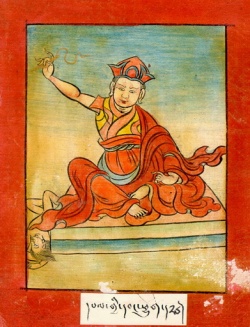Difference between revisions of "Karchen Pelgyi Wangchuk"
(Created page with "thumb|250px| Karchen Pelgyi Wangchuk (mkhar chen dpal gyi dbang phyug) was born into the Karchen clan, possibly the brother of Padmasambhava’...") |
|||
| Line 1: | Line 1: | ||
[[File:Palgyi_Wangchug.jpg|thumb|250px|]] | [[File:Palgyi_Wangchug.jpg|thumb|250px|]] | ||
| − | |||
| − | A layman, Pelgyi Wangchuk is said to have accompanied Padmasambava and Yeshe Tsogyel throughout Tibet teaching. | + | |
| + | |||
| + | |||
| + | |||
| + | [[Karchen Pelgyi Wangchuk]] ([[mkhar chen dpal gyi dbang phyug]]) was born into the [[Karchen]] {{Wiki|clan}}, possibly the brother of [[Padmasambhava’s]] [[consort]], [[Yeshe Tsogyel]] ([[ye shes mtsho rgyal]]). He mastered the [[Vajrakīla]] practices and could vanquish enemies simply by holding his [[kīla]] [[dagger]] high. | ||
| + | |||
| + | A [[layman]], [[Pelgyi Wangchuk]] is said to have accompanied [[Padmasambava]] and [[Yeshe Tsogyel]] throughout [[Tibet]] [[teaching]]. | ||
| Line 10: | Line 15: | ||
| − | Tarthang Tulku. 1975. Bringing the Teachings Alive. Cazadero, CA: Dharma Publishing, p. | + | [[Tarthang Tulku]]. 1975. Bringing the Teachings Alive. Cazadero, CA: [[Dharma Publishing]], p. |
| − | Smith, Gene. 2006. | + | Smith, Gene. 2006. “[[Siddha]] Groups and the [[Mahasiddhas]] in the [[Art]] and {{Wiki|Literature}} of [[Tibet]]”. In {{Wiki|Holy}} Madness: Portraits of [[Tantric]] [[Siddhas]]. [[New York]]: {{Wiki|Rubin Museum of Art}}, p. 72. |
| − | + | ’[[Jam mgon kong sprul blo gros mtha’ yas]]. 2007. [[Gter ston brgya rtsa]]. In [[Rin chen gter mdzod chen mo]]. {{Wiki|New Delhi}}: [[Shechen]], v.1 p. | |
| − | Gu ru bkra shis. 1990. Gu bkra’i chos ’byung. Beijing: Krung go’i bod kyi shes rig dpe skrun khang, pp. 172-173. | + | [[Gu ru bkra shis]]. 1990. [[Gu bkra’i chos ’byung]]. {{Wiki|Beijing}}: [[Krung go’i bod kyi shes rig dpe skrun khang]], pp. 172-173. |
Latest revision as of 18:50, 15 December 2015
Karchen Pelgyi Wangchuk (mkhar chen dpal gyi dbang phyug) was born into the Karchen clan, possibly the brother of Padmasambhava’s consort, Yeshe Tsogyel (ye shes mtsho rgyal). He mastered the Vajrakīla practices and could vanquish enemies simply by holding his kīla dagger high.
A layman, Pelgyi Wangchuk is said to have accompanied Padmasambava and Yeshe Tsogyel throughout Tibet teaching.
Sources
Tarthang Tulku. 1975. Bringing the Teachings Alive. Cazadero, CA: Dharma Publishing, p.
Smith, Gene. 2006. “Siddha Groups and the Mahasiddhas in the Art and Literature of Tibet”. In Holy Madness: Portraits of Tantric Siddhas. New York: Rubin Museum of Art, p. 72.
’Jam mgon kong sprul blo gros mtha’ yas. 2007. Gter ston brgya rtsa. In Rin chen gter mdzod chen mo. New Delhi: Shechen, v.1 p.
Gu ru bkra shis. 1990. Gu bkra’i chos ’byung. Beijing: Krung go’i bod kyi shes rig dpe skrun khang, pp. 172-173.
Arthur Mandelbaum August 2007
